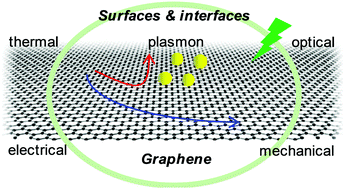当前位置:
X-MOL 学术
›
Chem. Soc. Rev.
›
论文详情
Our official English website, www.x-mol.net, welcomes your feedback! (Note: you will need to create a separate account there.)
The physics and chemistry of graphene-on-surfaces
Chemical Society Reviews ( IF 46.2 ) Pub Date : 2017-07-05 00:00:00 , DOI: 10.1039/c7cs00256d Guoke Zhao 1, 2, 3, 4, 5 , Xinming Li 5, 6, 7 , Meirong Huang 1, 2, 3, 4, 5 , Zhen Zhen 1, 2, 3, 4, 5 , Yujia Zhong 1, 2, 3, 4, 5 , Qiao Chen 1, 2, 3, 4, 5 , Xuanliang Zhao 1, 2, 3, 4, 5 , Yijia He 1, 2, 3, 4, 5 , Ruirui Hu 1, 2, 3, 4, 5 , Tingting Yang 1, 2, 3, 4, 5 , Rujing Zhang 1, 2, 3, 4, 5 , Changli Li 1, 2, 3, 4, 5 , Jing Kong 8, 9, 10, 11 , Jian-Bin Xu 5, 6, 7 , Rodney S. Ruoff 12, 13, 14, 15 , Hongwei Zhu 1, 2, 3, 4, 5
Chemical Society Reviews ( IF 46.2 ) Pub Date : 2017-07-05 00:00:00 , DOI: 10.1039/c7cs00256d Guoke Zhao 1, 2, 3, 4, 5 , Xinming Li 5, 6, 7 , Meirong Huang 1, 2, 3, 4, 5 , Zhen Zhen 1, 2, 3, 4, 5 , Yujia Zhong 1, 2, 3, 4, 5 , Qiao Chen 1, 2, 3, 4, 5 , Xuanliang Zhao 1, 2, 3, 4, 5 , Yijia He 1, 2, 3, 4, 5 , Ruirui Hu 1, 2, 3, 4, 5 , Tingting Yang 1, 2, 3, 4, 5 , Rujing Zhang 1, 2, 3, 4, 5 , Changli Li 1, 2, 3, 4, 5 , Jing Kong 8, 9, 10, 11 , Jian-Bin Xu 5, 6, 7 , Rodney S. Ruoff 12, 13, 14, 15 , Hongwei Zhu 1, 2, 3, 4, 5
Affiliation

|
Graphene has demonstrated great potential in next-generation electronics due to its unique two-dimensional structure and properties including a zero-gap band structure, high electron mobility, and high electrical and thermal conductivity. The integration of atom-thick graphene into a device always involves its interaction with a supporting substrate by van der Waals forces and other intermolecular forces or even covalent bonding, and this is critical to its real applications. Graphene films on different surfaces are expected to exhibit significant differences in their properties, which lead to changes in their morphology, electronic structure, surface chemistry/physics, and surface/interface states. Therefore, a thorough understanding of the surface/interface properties is of great importance. In this review, we describe the major “graphene-on-surface” structures and examine the roles of their properties and related phenomena in governing the overall performance for specific applications including optoelectronics, surface catalysis, anti-friction and superlubricity, and coatings and composites. Finally, perspectives on the opportunities and challenges of graphene-on-surface systems are discussed.
中文翻译:

表面石墨烯的物理化学
石墨烯因其独特的二维结构和特性(包括零带隙结构,高电子迁移率以及高电导率和热导率)而在下一代电子产品中显示出巨大潜力。原子厚的石墨烯集成到器件中总是涉及其通过范德华力和其他分子间力甚至共价键与支撑衬底的相互作用,这对于其实际应用至关重要。预期在不同表面上的石墨烯薄膜将表现出显着的性能差异,这将导致其形态,电子结构,表面化学/物理和表面/界面状态发生变化。因此,对表面/界面特性的透彻理解非常重要。在这篇评论中,我们描述了主要的“表面石墨烯”结构,并研究了它们的特性和相关现象在控制特定应用(包括光电学,表面催化,减摩和超润滑性以及涂料和复合材料)的整体性能中的作用。最后,讨论了关于石墨烯表面体系的机遇和挑战的观点。
更新日期:2017-07-05
中文翻译:

表面石墨烯的物理化学
石墨烯因其独特的二维结构和特性(包括零带隙结构,高电子迁移率以及高电导率和热导率)而在下一代电子产品中显示出巨大潜力。原子厚的石墨烯集成到器件中总是涉及其通过范德华力和其他分子间力甚至共价键与支撑衬底的相互作用,这对于其实际应用至关重要。预期在不同表面上的石墨烯薄膜将表现出显着的性能差异,这将导致其形态,电子结构,表面化学/物理和表面/界面状态发生变化。因此,对表面/界面特性的透彻理解非常重要。在这篇评论中,我们描述了主要的“表面石墨烯”结构,并研究了它们的特性和相关现象在控制特定应用(包括光电学,表面催化,减摩和超润滑性以及涂料和复合材料)的整体性能中的作用。最后,讨论了关于石墨烯表面体系的机遇和挑战的观点。


























 京公网安备 11010802027423号
京公网安备 11010802027423号